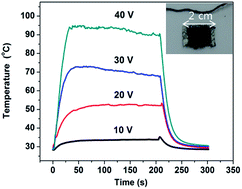Highly efficient CNT functionalized cotton fabrics for flexible/wearable heating applications†
Abstract
In this work, a highly efficient, flexible electro thermal heater based on highly conductive carbon nanotube functionalized cotton fabrics has been studied. Cotton fabrics were functionalized with single walled carbon nanotubes through a simple dip coating method. To explore their potential as heaters, electrothermal performances of the devices were studied in terms of applied voltage, heating rate and input power density. The highly flexible heater is constructed based on uniformly interconnected CNT networks, which yields an effective and rapid heating of the heater at low input power. The investigation results suggest promising applications of these devices in wearable electronics and beyond and they could also be woven into textile materials.


 Please wait while we load your content...
Please wait while we load your content...